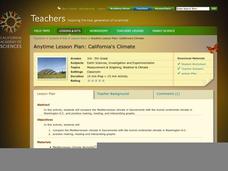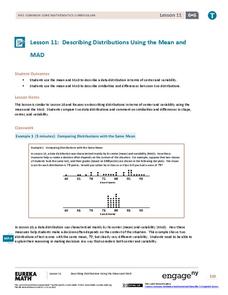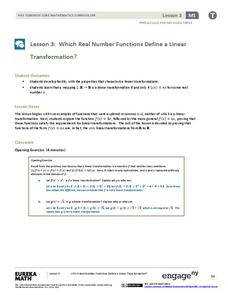Curated OER
The Outsiders Study Guide
Provide this packet for your pupils as they pour over The Outsiders by S.E. Hinton. The study guide includes graphic organziers and comprehension as well as higher-level questions. Class members briefly summarize each chapter, compare...
Livaudais-Baker English Classroom
Lord of The Flies Chapter Questions
Chapter-by-chapter worksheets ask readers to find specific examples of characterization, symbolism, setting, conflict, themes, and main ideas in William Golding's Lord of the Flies. Also included in the packet is an assignment sheet that...
La Jolla High School
Of Mice and Men by John Steinbeck: Who Said This?
Can your class figure out who said what just by looking at a quotation? This activity for Of Mice and Men includes 11 quotations from the novel. Use this quote sheet as a light activity to get your readers to look back into the text or...
Curated OER
Where the Red Fern Grows Chapter 10-11 Worksheet
Focus on characterization in Wilson Rawls' well-known novel. First, learners answer a series of questions about the chosen chapters, paying attention to plot, use of language, and character interactions. Then, using the provided Venn...
IPDAE
Themes in Short Stories
"What is the theme of this story?" The very question can spark fear in the minds of readers and incinerate confidence. Here you will discover an exercise that shows how writers use the tools of setting, plot, conflict, and...
Prestwick House
The House on Mango Street Activity Pack
Enrich a unit on The House on Mango Street by Sandra Cisneros with a selection of related activities. The packet contains nine activities that go from pre-reading through wrapping up the novel. Young readers work on studying...
Prestwick House
Anne Frank: The Diary of a Young Girl
Pre-reading worksheets, discussion prompts, activity ideas, research assignments, and more await you in this resource for supplementing your class reading of The Diary of a Young Girl by Anne Frank.
Livaudais-Baker English Classroom
Lord of the Flies Exam
Assess readers' comprehension of William Golding's Lord of the Flies with an exam that includes matching, true/false, and multiple-choice questions.
Mr. Mansour
Ralph S. Mouse by Beverly Cleary
Take an in-depth look into Beverly Cleary's story, Ralph S. Mouse, with a 10-question worksheet that focuses on story elements. Scholars describe the main character, point of view, conflict resolution, and more! Then, conclude with...
Curated OER
Character Builder
Characters in a story are more than a name to remember. Use a character builder worksheet to write out a character's appearance, background, personality, attributes, and story relevance, including whether they are a main or minor...
Do2Learn
Reading Response Form
What makes a character believable? Have learners write a response to this question by explaining why they found the characters in a given story or novel to be believable or not believeable.
Curated OER
Understanding Protagonists and Antagonists
How can you tell if a character is a villain? What about a hero? Work on literary analysis with an engaging language arts worksheet. After completing an activity about the four types of conflict, learners fill out a character map about a...
Curated OER
Piano Lessons
Playing the piano takes a lot of work, even before you touch the keys! Use a reading passage about learning to play the piano before answering five comprehension questions.
Education Center
Terrific Teamwork!
After reading Officer Buckle and Gloria by Peggy Rathmann, have your first graders differentiate between Gloria's actions and Officer Buckle's actions. Using a Venn diagram organizer, kids cut out various events from the story and...
K5 Learning
Will the Wolf
How well can a wolf survive without a pack? Third graders read about headstrong Will and his desire to be an independent wolf with a short story and series of comprehension questions.
MENSA Education & Research Foundation
Magical Musical Tour: Using Lyrics to Teach Literary Elements
Language arts learners don't need a lecture about poetry; they listen to poetry every day on the radio! Apply skills from literary analysis to famous songs and beautiful lyrics with a lesson about literary devices. As...
Los Angeles County Office of Education
California State Standards: Algebra I
Starting a year of Algebra I? This mighty packet practices all of the major topics with different ranges of difficulty. Standards include everything from linear to quadratic to rational expressions. Use it in a...
EngageNY
Characteristics of Parallel Lines
Systems of parallel lines have no solution. Pupils work examples to discover that lines with the same slope and different y-intercepts are parallel. The 27th segment of 33 uses this discovery to develop a proof, and the class determines...
California Academy of Science
California's Climate
The United States is a large country with many different climates. Graph and analyze temperature and rainfall data for Sacramento and Washington DC as you teach your class about the characteristics of Mediterranean climates. Discuss the...
EngageNY
Describing Distributions Using the Mean and MAD II
The 11th lesson in the series of 22 is similar to the preceding lesson, but requires scholars to compare distributions using the mean and mean absolute deviation. Pupils use the information to make a determination on which data set is...
Sundance
Teaching Strategies: The Giver
Can utopia be achieved? Included here are three literature worksheets to pair with Lois Lowry's The Giver. Pupils work in groups to come up with solutions to society's issues, individuals back up a statement related to a topic in the...
EngageNY
Which Real Number Functions Define a Linear Transformation?
Not all linear functions are linear transformations, only those that go through the origin. The third lesson in the 32-part unit proves that linear transformations are of the form f(x) = ax. The lesson plan takes another look at examples...
Balanced Assessment
Local and Global Behavior
Create rules for numerical sequences. Pupils develop local rules and recursive rules for number sequences. The sequences are linear, quadratic, and cubic in nature. Scholars find that some local rules do not work, no matter where in...
EngageNY
The Slope of a Non-Vertical Line
This lesson introduces the idea of slope and defines it as a numerical measurement of the steepness of a line. Pupils then use the definition to compare lines, find positive and negative slopes, and notice their definition holds for...
Other popular searches
- Indirect Characterization
- Adjectives Characterization
- Teaching Characterization
- Characterization Worksheets
- Chaucer's Characterization
- Characterization Power Point
- Direct Characterization
- Analyze Characterization
- Characterization Literature
- Characterization Test
- Characterization in Fiction
- Characterization Methods























